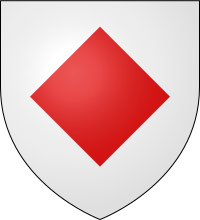
Back Routa (heraldika) Czech Raute (Heraldik) German Losange (heráldica) Spanish Ruutu (heraldiikka) Finnish Macle (héraldique) French Ruta (heraldika) Hungarian Losanga (araldica) Italian ロズンジ (紋章学) Japanese Lisonja Portuguese ข้าวหลามตัด (มุทราศาสตร์) Thai
This article includes a list of general references, but it lacks sufficient corresponding inline citations. (September 2014) |

The lozenge in heraldry is a diamond-shaped rhombus charge (an object that can be placed on the field of the shield), usually somewhat narrower than it is tall. It is to be distinguished in modern heraldry from the fusil, which is like the lozenge but narrower, though the distinction has not always been as fine and is not always observed even today. A mascle is a voided lozenge—that is, a lozenge with a lozenge-shaped hole in the middle—and the rarer rustre is a lozenge containing a circular hole in the centre. A lozenge throughout has "four corners touching the border of the escutcheon".[1] A field covered in a pattern of lozenges is described as lozengy; similar fields of mascles are masculy, and fusils, fusily (see Variation of the field). In civic heraldry, a lozenge sable is often used in coal-mining communities to represent a lump of coal.

A lozenge-shaped escutcheon is used to depict heraldry for a female (in continental Europe especially an unmarried woman), but is also sometimes used as a shape for mural monuments in churches which commemorate females, as a shield was considered inappropriate for women who did not generally participate in combat; for the same reason, clergymen were also sometimes given oval-shaped arms.[2][3] Funerary hatchments are generally shown within lozenge shaped frames, for both male and female deceased.
- ^ Fox-Davies, Arthur Charles (1909). A Complete Guide to Heraldry. London and Edinburgh: T. C. & E. C. Jack. p. 146.
- ^ "Coat-of-arms is Bishop Maurus Caruana's". Times of Malta. January 3, 2010.
- ^ For example the lozenge shaped monument to Arabella Morgan (1741-1828) in St Andrew's Church, High Ham, Somerset, see image File:St Andrew's Church, High Ham2.jpg
© MMXXIII Rich X Search. We shall prevail. All rights reserved. Rich X Search